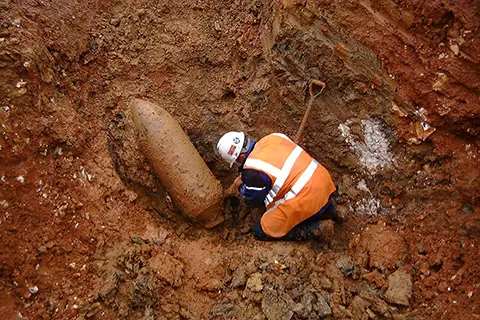Igne's UXO research team keeps construction workers safe
Specialising in understanding the ongoing threat posed by the explosive impact of bombing raids during WWI and WWII, every day is also a school day for the team of dedicated researchers at Igne.
No matter the department you work in, a career with Igne is different every single day – and a job at Igne is certainly not your ordinary 9 to 5!
After all, there are few commercial companies operational globally where staff can be proud of the fact they help save lives every single day…
Specialising in understanding the ongoing threat posed by the explosive impact of bombing raids during WWI and WWII, every day is also a school day for the team of dedicated researchers at Igne.
Here the research team shares the most interesting things they’ve learned during their time with the company so far.
Robert Cliff – learning about the different types of bomb fuses was cool! Particularly the innovative use of electrical, mechanical and chemical elements in the design of German bombs.
It’s a testament to their incredible design that many of these devices still remain viable 75 years later. Obviously, that’s not good for construction workers in the UK who could encounter one of these unexploded bombs…but that’s where our work comes in. We provide detailed site-specific risk assessments to protect them from inadvertently unearthing anything dangerous.
James Armstrong – before starting at Igne, I didn’t realise how far unexploded bombs (UXBs) could penetrate into the ground.
I learned that they often follow what’s called the J-curve effect. Basically, the J-curve happens because after penetrating the ground, a bomb can continue its line of flight and even turn in an upwards curve towards the surface of the ground as they come to rest – i.e., in a ‘J’ shape.
Before joining Igne I certainly didn’t know that because of this effect, unexploded bombs could come to rest so far from their point of entry – some have been discovered up to 15m away.
It’s shocking to know that because of this effect, an unexploded bomb could be sitting beneath an intact WWII-era building to this day.
Patrick Weller – I enjoy understanding how communities responded during WWII. For example, people from Ramsgate built tunnels beneath the town and would descend to escape from the bombings.
They even built shops down there!
Kelly Barshell – one site I was studying was part of an experimental firing range. Previous unexploded ordnance (UXO) surveys across other areas of the range found items of UXO which never progressed further than the testing phase, making identifying them near impossible.
Igne’s research department use their exceptional historical knowledge to delve into site history and provide detailed unexploded ordnance risk assessments.
Interested in joining the team? Find your future with a career at Igne… or do you need the expert skills of Igne’s researcher to ensure your project is UXO free? Contact the team for a free initial consultation today: call 01634 471 340 or email hello@igne.com.
Other articles of interest

Who should you trust to conduct a UXO risk assessment?
A UXO risk assessment is a necessity you just want to tick off your to do list as quickly as possible. However, with more and more suppliers to choose from, how do you pick the best provider?

How UXO risk assessments keep clients on time and budget
Igne's research team create detailed UXO risk assessments so clients can determine the risk level of their sites.


